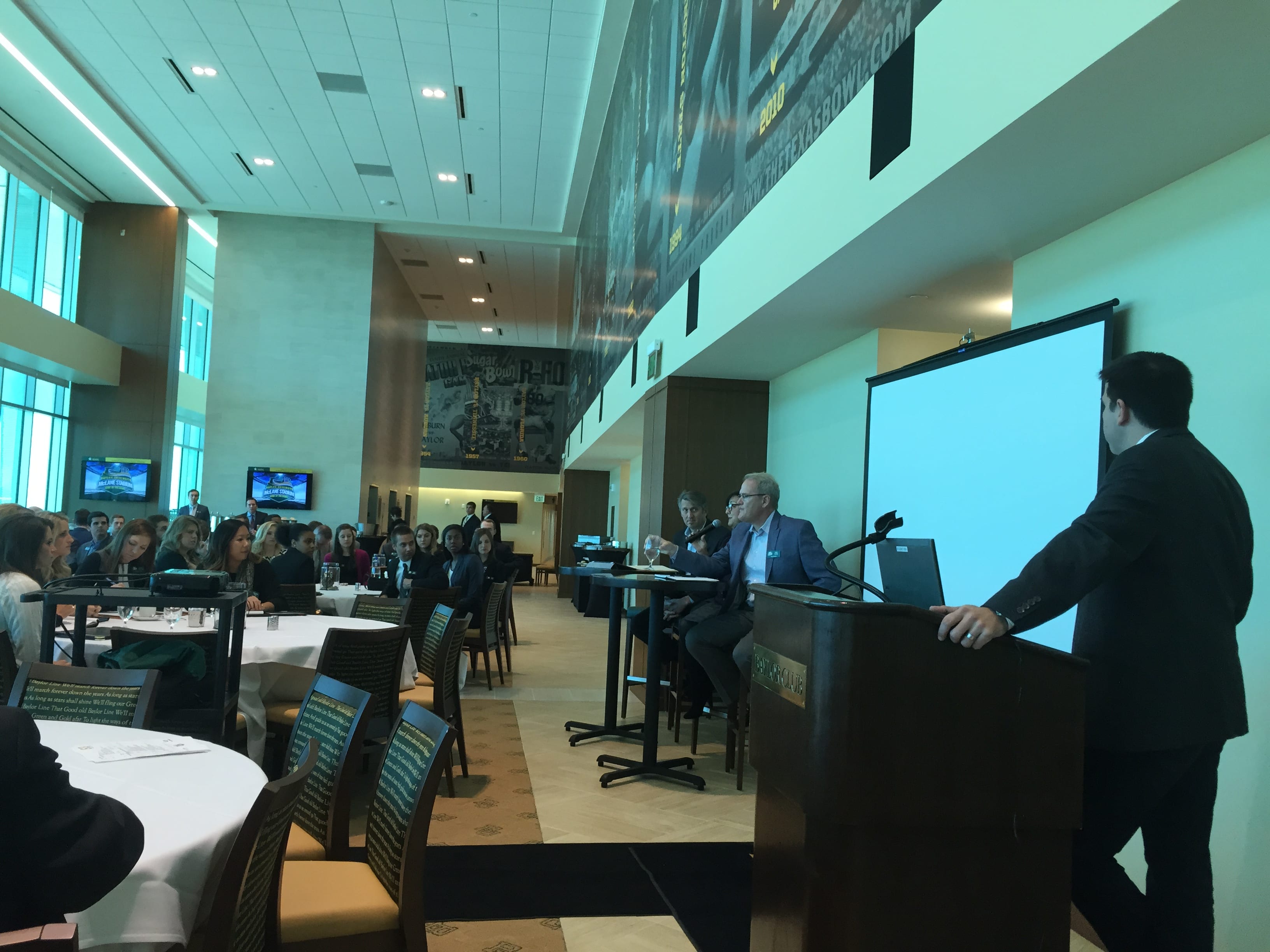by Kirk Wakefield – December 2014
At the 2014 Sports Sponsorship & Sales (S3) Board Meeting held at McLane Stadium on the campus of Baylor University on November 11-12, Jose Lozano hosted a panel of fellow brand experts from the S3 Board to discuss, “How brands measure successful partnerships.”
Not in the awareness business
“We are not in the awareness business,” said Kelly Roddy, President of Schlotzsky’s, which is owned by Focus Brands (Auntie Anne’s, Cinnabon, Carvel, McAlister’s Deli, and Moe’s Southwest Grill). “We are into meaningful relationships and sponsorships provide this,” added Roddy.
These sentiments were reinforced by Bill Moseley, Director of Marketing Communications, AT&T, and one of the architects of a wide variety of AT&T corporate partnership deals. Mr. Moseley noted that account management of corporate partners may have focused on more static venue elements of an agreement in the past, but that, “Today the emphasis is on adding value to the fan experience through creative strategies. The AT&T brand is an integral part of the game day experience.”
Tami T. Walker, Brand Manager for Phillips 66, shared, “When we can get a father and son on the floor [as part of a brand-fan experience] we make fans of the brand for life.” The emphasis is on creating memorable experiences that clearly link the brand with the property in the minds of fans that result in driving business.
What do brands care about in a sponsorship deal?
At the end of the day, or at the end of each year and at the end of the contract, brands care about sponsorship return-on-investment. The panel members underscored that the reason behind sponsorships isn’t because someone at the brand loves the team. Rather, the brand cares about what drives traffic and builds their fan loyalty–when fans of the team become fans of the brand.
AT&T, Phillips 66, Schlotzsky’s, and other well-established brands care most about how much fan affinity transfers to the brand. Why? Brands can track the lift they receive among fans of the brand compared to non-fans in the same markets. Using research tools and brand tracking, brands can see if fans of the team behave differently.
[dropshadowbox align=”right” effect=”lifted-both” width=”200px” height=”” background_color=”#ffffff” border_width=”1″ border_color=”#dddddd” ]”Impressions don’t matter.”[/dropshadowbox]Mr. Roddy explained, “When we measure fan engagement we can see the connection with sales increases. We now look for ways to track call to action. We aren’t interested in millions of impressions, but measures of affinity transfer to our brand. Impressions don’t matter.”
How do brands keep score?
When Phillips 66 evaluates sponsorships, senior management keeps score at the bottom line.Tami Walker emphasized that Phillips 66 uses multivariate analysis on net promoter and other key performance indicators (KPIs) to look at drivers of buying behaviors. The make-or-break decision for their partnerships is whether or not the property, “can produce creative solutions we can’t get elsewhere,” added Ms. Walker. Brand managers, like Ms. Walker, must focus on managing contracts in an effective manner to prove the relationship with KPIs.
Other tracking measures include social media scraping. Mr. Roddy explained, “It’s important to see if our brand is connected to the partner via fans’ social media. For example, are people posting about Cinnabon and the Texans?” Using sophisticated web crawler software, brands can analyze social media posts to determine if such a linkage increases as a part of a partnership promotion. Brands also use loyalty index tracking to compare loyalty levels of fans versus non-fans of a property.
Mr. Moseley said that AT&T partners understand that the Net Promoter Score is an important KPI, as they want customers to recommend the brand to others. In doing so, the benefit of the partnership is that the brand-fan linkage helps overcome any pain point with the provider who brings life to their devices.
When is added value really added value?
As Ms. Walker emphasized, building loyalty to the brand is more than just distributing loyalty cards or gaining name recognition. Partners seek true loyalty that shields them against competitive inroads. Properties add value through brand-fan experiences that can scale the effects through social media, as fans share the experiences with others.
For example, the 76 fuel brand partners with the Dodgers, who act as true partners to assess results and adjust to meet their partnership goals. In this sense, the property adds value through their transparency, honesty, and willingness to solve problems.
Jose Lozano, who as CEO of The Company, works with a number of national brands engaged in partnerships, encourages properties to bring their own passion into the equation. Try to understand what each brand wants, seeking to understand the brand’s customers and what they really want. Rather than arriving with a prescribed inventory of sponsorship assets, properties should identify the brand’s KPIs and find ways to bring the brand to life among their fans. When the team’s partnership executives understand how the brand measures success, they can begin to add value beyond the standard rate card for sponsorships.





